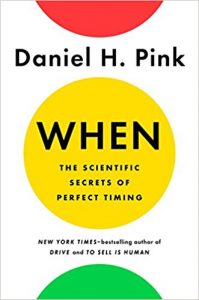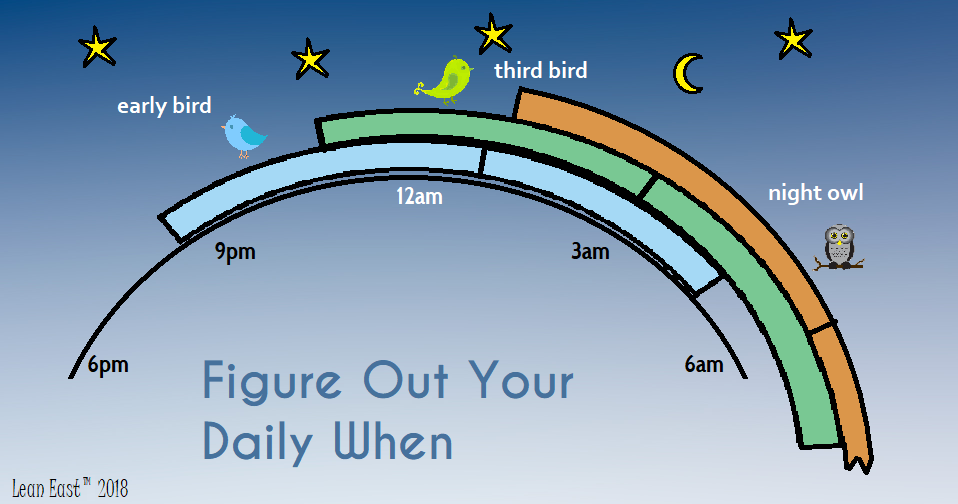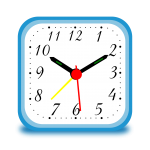
This post is a summary of the key learnings from the 2018 book, When: The Scientific Secrets of Perfect Timing by Daniel H. Pink. The book was an instant bestseller from the well-known author and draws upon recent research from psychology, biology, neuroscience, and economics. It is easy to read with many great examples and stories to demonstrate that Timing is really a science. This post by Lean East synthesizes the main takeaways from each chapter of the book to save our readers some time!
Figure Out Your Daily When
Are you a morning lark, night owl, or third bird? To find out, identify the midpoint of your typical night’s sleep- halfway between going to sleep and waking up. If the midpoint is before 3 AM you are probably a lark. If the midpoint is after 6 AM you are an owl (about 1/5 of people) and everyone in the middle is a third-bird (nearly 2/3 of people). Now, use the Daily When Chart below to figure out times of peak performance:


When to Exercise
Exercise in the morning to lose weight, boost your mood, build strength and help you stick to the routine.
Exercise in the late afternoon or evening to avoid injury, perform your best, and enjoy your workout a little more!
Four Tips for a Better Morning
- Drink a glass of water when you wake up to re-hydrate after the night.
- Don’t drink coffee immediately after you wake. Drink your first cup 60-90 minutes after waking so you don’t interfere with the normal cortisol in your system.
- Soak up the morning sun to wake up.
- Schedule talk therapy appointments for the morning when your cortisol levels are highest.
Schedule Break Times
Ensure you take breaks throughout the day to recover and regenerate. Schedule them in your calendar! Here are five kinds of breaks:
- Micro-breaks (less than a minute to get a drink or stretch)
- Moving breaks (5-minute walks, a few yoga poses, or push-ups are recommended)
- Nature breaks (walk outside)
- Social breaks (phone a friend or meet for coffee)
- Mental gear-shifting break (meditation or controlled breathing)
Take the Perfect Nap
- Identify your optimal nap time (often between 2 and 3 PM, or about 7 hours after waking)
- Create a peaceful environment
- Down a cup of coffee (don’t worry – it will take 25-minutes for the caffeine to work)
- Set your phone timer for 25-minutes (get at least 5-minutes of sleep and less than 30)
- Repeat consistently to maximize the benefits
Beginnings
When should you begin a new goal or project? The New Year is a common time for resolutions and a fresh start, but you can also plan a start on the first day of a month, season, or on an important holiday or anniversary.
Perfect timing when going first gives you an edge:
- Being written first on a ballot
- Job Interviews – if you are not the default choice in an interview you may get a fresh look
- If there are few competitors you may benefit from the “primary effect”
Not so perfect timing when you should not go first:
- When you are the default choice
- If there are many competitors
- When the environment is unclear, going later allows the decision-makers to sharpen their focus
- If the competition is meager
Midpoints
We often remember beginnings and endings while midpoints become forgotten. Here are some ways to avoid midpoint slumps in projects and in life.
For projects, set interim goals and publicly commit to the goals. This helps us turn a midpoint into an interim end goal while outsiders hold us accountable.
Another technique is to maintain a streak of daily progress. Set an easy minimum goal but do it every day. The Duolingo app for learning a language uses this technique – just 5 minutes a day completed every day for two years = over 60 hours of concentrated study!
Five Ways to Combat a Midlife Slump
- Prioritize your top goals. Try the Warren Buffet technique:
- Write down your top 25 goals for life,
- Prioritize your top five from the list,
- Decide how to begin working on your top five and cross off the rest.
- Develop (or use) mid-career mentoring within your organization
- Be grateful for the chance encounters in your life that have been positive (for example, what chance encounters and decisions led to meeting your spouse?)
- Write yourself a short note of self-compassion (for a situation you regret or feel bad about)
- Don’t take any action. Many slumps are like bad colds – they go away.
Endings
Endings are often the most memorable parts of a book, vacation, project, event, etc. Here are three areas where you can create better endings:
- The workday: Reserve the final five minutes of your workday to record what you accomplished during the day and lay out a plan for the next day. With any remaining time, send a thank you note out to someone – it will benefit both them and you!
- A vacation: Plan an elevating final experience – how the vacation ends often shapes the entire trip in your memory.
- A purchase: Little touches at the end will elevate a customer’s experience. So, provide the mint with the check, shake the customer’s hand, or add a small bonus at the end to increase your customer’s satisfaction.
When to Quit a Job
Here are five questions to help you decide about moving on:
- Do you want to be in this job on your next work anniversary?
- Is your current job both demanding and in your control?
- Does your boss allow you to do your best work?
- Are you outside the 3-5-year salary bump window?
- Does your daily work align with your long-term goals?
Getting in Sync with Others
Author Daniel Pink ends his book with examples of collaborations with others where you can experience your own “syncher’s high” and lift your physical and psychological well-being. Here are seven ways you can collaborate with others to experience this high:
- Sing in a chorus
 Run together (or bike, play basketball, etc.)
Run together (or bike, play basketball, etc.)- Row crew
- Dance
- Join a yoga class
- Flash mob
- Cook in tandem
We hope you enjoyed this summary of many key tips and learnings from the book, When: The Scientific Secrets of Perfect Timing. Please leave comments and ask questions below, and read the book for all the examples and details.
Endings matter, and Daniel Pink strategically ends his book with a simple, yet powerful line:
“I used to believe that timing was everything. Now I believe that everything is timing.”

 Run together (or bike, play basketball, etc.)
Run together (or bike, play basketball, etc.)
Related Posts
How I am Changing the Career Advice I Give My Kids
This is Never Going to Work: Getting Lean Projects Unstuck
How to Speak so that People Want to Listen